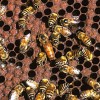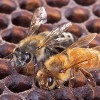 The general public can take several steps to avoid encountering honey bee swarms or colonies. The first and most important step is for citizens to educate themselves and their families about the AHB. This 3-page fact sheet provides links to valuable resources, definitions of key terms, and touches on general precautions and bee-proofing. Written by M. K. O’Malley, J. D. Ellis and A. S. Neal, and published by the UF Department of Entomology and Nematology, October 2014. (Photo: Scott Bauer, USDA/ARS)
The general public can take several steps to avoid encountering honey bee swarms or colonies. The first and most important step is for citizens to educate themselves and their families about the AHB. This 3-page fact sheet provides links to valuable resources, definitions of key terms, and touches on general precautions and bee-proofing. Written by M. K. O’Malley, J. D. Ellis and A. S. Neal, and published by the UF Department of Entomology and Nematology, October 2014. (Photo: Scott Bauer, USDA/ARS)
http://edis.ifas.ufl.edu/in739
Tag: M. K. O’Malley
Frequently Asked Questions about the Africanized Honey Bee in Florida
 The African honey bee, Apis mellifera scutellata, was introduced into South America from the central and southern part of Africa in 1957. Since its introduction into South America, the African bee has migrated into the southwestern United States and Florida. Apis mellifera scutellata is the African bee subspecies referred to in this 3-page fact sheet, which answers commonly asked questions about these bees and their behavior. Written by M. K. O’Malley, J. D. Ellis and A. S. Neal, and published by the UF Department of Entomology and Nematology, November 2014.
The African honey bee, Apis mellifera scutellata, was introduced into South America from the central and southern part of Africa in 1957. Since its introduction into South America, the African bee has migrated into the southwestern United States and Florida. Apis mellifera scutellata is the African bee subspecies referred to in this 3-page fact sheet, which answers commonly asked questions about these bees and their behavior. Written by M. K. O’Malley, J. D. Ellis and A. S. Neal, and published by the UF Department of Entomology and Nematology, November 2014.
http://edis.ifas.ufl.edu/in738
ENY158/IN874 Explaining the Best Management Practices for Maintaining European Honey Bee Colonies
ENY158, a 4-page fact sheet by M. K. O’Malley, J.D. Ellis and G. W. Hayes, Jr., outlines and explains the 12 recommendations listed in the voluntary agreement between Florida beekeepers and state officials to minimize the spread of African honey bees. Published by the UF Department of Entomology and Nematology, October 2010.
http://edis.ifas.ufl.edu/in874
ENY152/IN868 The Benefits of Pollen to Honey Bees
ENY152, a 4-page illustrated fact sheet by Amanda Ellis, Jamie Ellis, Michael O’Malley and Catherine Zettel Nalen, provides an overview of the nutritional needs of honey bees with an emphasis on the role of pollen — nutritional content, where it is produced, how it is collected, and how to ensure colony nutrition. Published by the UF Department of Entomology and Nematology, September 2010.
http://edis.ifas.ufl.edu/in868
ENY141S/IN864 Cómo Lidiar con Abejas Africanas: Una Guía Práctica
ENY141S, a 4-page fact sheet by M. K. O’Malley, J. D. Ellis, Pablo Herrera and A. S. Neal, is the Spanish language version of ENY-141/IN739 What to do about African Honey Bees: A Consumer Guide. It provides information about Africanized honey bees (AHB), which have been labeled ”killer” bees, steps people can take to avoid negative interactions, how to handle stings, and bee-proofing basics. Published by the UF Department of Entomology and Nematology, August 2010.
http://edis.ifas.ufl.edu/in864
ENY140S/IN862 Preguntas Frecuentes Acerca de la Abeja Melífera Africanizada en Florida
ENY-140S, a 3-page fact sheet by M. K. O’Malley, J. D. Ellis, P. Herrera and A. S. Neal, is the Spanish language version of ENY140/IN738 Frequently Asked Questions about the Africanized Honey Bee in Florida. It provides information about Africanized honey bees (AHB) in a question-and-answer format. Published by the UF Department of Entomology and Nematology, August 2010.
http://edis.ufl.edu/in862
ENY147/IN784 Differences Between European and African Honey Bees
ENY147, a 3-page illustrated fact sheet by M. K. O’Malley, J. D. Ellis and C. M. Zettel Nalen, describes key differences between the agressive African bee and the docile European honey bee, including hive defense and stinging, swarming and absconding, selection of nesting site. Includes references. Published by the UF Department of Entomology and Nematology, October 2009.
http://edis.ifas.ufl.edu/IN784
ENY748/IN785 Swarm Trapping for Pest Control Operators
ENY748, a 6-page illustrated fact sheet by M. K. O’Malley, J. D. Ellis and C. M. Zettel Nalen, outlines the standard operating procedures for swarm trapping by certified Pest Control Operators as a means of capturing and removing a nesting Africanized bee colony before the bees become aggressive. Published by the UF Department of Entomology and Nematology, October 2009.
http://edis.ifas.ufl.edu/IN785
ENY147S/IN863 Diferencias Entre Abejas Melíferas Europeas y Africanas
ENY-147S, a 3-page illustrated fact sheet by M. K. O’Malley, J. D. Ellis, C. M. Zettel Nalen and Pablo Herrera, is the Spanish language version of ENY147/IN784 Differences between European and African Honey Bees. It describes key differences between these two sub-species of Apis mellifera in their hive defense and stinging, swarming and absconding, and selection of nesting site. Includes references. Published by the UF Department of Entomology and Nematology, August 2010.
http://edis.ifas.ufl.edu/in863
ENY144/IN771 Choosing the Right Pest Control Operator for Honey Bee Removal: A Consumer Guide
ENY-144, a 6-page illustrated fact sheet by M. K. O’Malley and J. D. Ellis, guides Florida resident in ensuring that the honey bees on his or her property are safely and professionally removed. Includes references. Published by the UF Department of Entomology and Nematology, September 2008.
http://edis.ifas.ufl.edu/IN771
ENY145/IN778 Removal of Swarms and Colonies for Pest Control Operators
ENY-145, a 12-page illustrated fact sheet by Michael K. O’Malley, Jamie D. Ellis and P. G. Koehler, outlines for pest control operators the standard operating procedures for removing swarms and colonies. Includes additional resources and contacts. Published by the UF Department of Entomology and Nematology, November 2008.
http://edis.ifas.ufl.edu/IN778
ENY146/IN783 Living with African Bees in Florida’s Outdoor Workplaces
ENY-146, a 5-page illustrated fact sheet by M. K. O’Malley and J. D. Ellis, offers African honey bee related recommendations and precautions specific to outdoor workers in Florida. Includes references. Published by the UF Department of Entomology and Nematology, June 2008.
http://edis.ifas.ufl.edu/IN783
ENY-1000/IN758 Insects, Oh Yes!
ENY-1000, a 10-page illustrated fact sheet by S. McCann, J. D. Ellis, and M. K. O’Malley, is a general overview of insects, their importance, and their biology. It is designed as a supplemental elementary school curriculum for Grades 1-3, although it can apply to older or younger children as well. Published by the UF Department of Entomology and Nematology, December 2008.
http://edis.ifas.ufl.edu/IN758
ENY-1001/IN759 Guide to Collecting and Maintaining Live Arthropods for Classroom Display in Florida
ENY-1001, a 6-page illustrated fact sheet by S. McCann, J. D. Ellis, and M. K. O’Malley, details the process of maintaining live insect displays for educational purposes in Florida. Includes references. Published by the UF Department of Entomology and Nematology, January 2008.
http://edis.ifas.ufl.edu/IN759